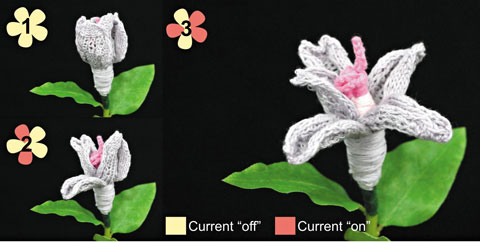Department News
[ChosunBiz]Engineers develop temperature dependent 'moving fabric'… Motorless robots may come to reality soon
Engineers develop temperature dependent <?xml:namespace prefix = "o" ns = "urn:schemas-microsoft-com:office:office" />
'moving fabric'… Motorless robots may come to reality soon
Announced by SNU college of Mechanical and Aerospace Engineering
Inspired by the principle behind knitting
The white lily bloomed its petals as springtime approached- so did the daffodils and the calla flowers. However, upon taking a closer look, the flowers were artificially made, knitted with yarn. The researchers in Korea have developed a weaving technique that changes the shape of the fabric as desired by receiving current or heat using the knitting principle. It is expected to be utilized in the form of motor-less robots or to change the shape of the car depending on the air flow.
On the 5th of April, Professor Sung-Hoon Ahn of Seoul National University, college of Mechanical and Aerospace Engineering, has proudly presented his research on the development of the 'moving fabric' that could alter its shape into desired shape depending on the temperature. The study was published on the cover page of 'Advanced Materials' (a weekly peer-reviewed scientific journal) on the 4th of April.
The lead author is Min-Woo Han, a doctoral researcher in Seoul National University.

▲ The picture depicts a lily made of moving fabric. The petals that received the current opens as the
shape-memory alloy inside the chamber moves. The figures on the petals show the current supply in
sequence. Yellow represents broken current, while orange represents current supply./ SNU
The researchers wrapped the shape-memory alloy with fiber into a 'yarn' and then knitted the fabric. Shape-memory alloys are metals with characteristic that shrink by 5-6% at higher temperatures. However, it is ductile and malleable in low temperatures and thus is easier to create the desired shape.
Professor Ahn has. mentioned that, "by utilizing the knitting technique we could diversify the shapes of shape memory alloy fabrics. Thus, increasing temperature will alter the direction and shape of how the material would bend." For example, the shape-memory alloy fabric that forms the center of the petals would curved outward when the temperature increases, and the ends of the petals would curl inward.
Also, if current is only given to a specific petal or is heated with a hair dryer, the shape of the specific area affected would change. Furthermore, the order in which the petals are laid out can also be adjusted. The researchers call it a "fabric actuator" because the shape-memory alloy fabric moves without a motor. Professor Ahn Sung Hoon mentions that, "if you apply it to a fish robot, you can move the fins without a motor," and that "you can change the outline of your car to suit the airflow."
However, are the movements reversible? Ahn has said, "it is the same shape as reflected in a mirror, but it can be reversed by using fabric in the opposite direction." The results of this study will be published soon.
(Chosun Biz: Lee Young-wan, science journalist)
Check out Related Articles
http://biz.chosun.com/site/data/html_dir/2017/04/06/2017040600029.html

